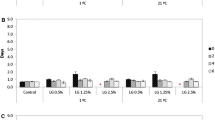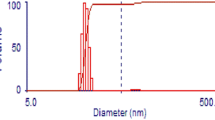Abstract
The food industry faces challenges in maintaining food quality, preservation, and safety. Chemical preservatives like sodium benzoate and potassium sorbate can change the odor, taste, and texture of fruit juices. So, there is consumer demand for safe and eco-friendly food preservatives which are of natural origin. Therefore, in the present study, oregano essential oil–based nanoemulsion has been prepared for use as a natural preservative. Oregano essential oil (OEO)-based nanoemulsion was prepared using of oregano essential oil, Tween80, and water by ultrasonic emulsification. The average droplet diameter of the stable formulated nanoemulsion was 22 nm with polydispersity index (PDI) of 0.107 and spherical morphology. The optimized formulation showed significant antibacterial activity against Escherichia coli, affecting membrane permeability and causing bacterial death and lysis. To test whether the antibacterial activity would translate to food systems, antibacterial activity of selected oregano oil nanoemulsion in fresh fruit juice (mango) was determined using sodium benzoate as positive control. The shelf life of the mango juice was extended up to 120 h by incorporating oregano essential oil nanoemulsion. The nanoemulsion exhibited better antimicrobial activity at 4 °C storage than at 25 °C. This study suggests that oregano oil nanoemulsion could be used as a natural preservative for preserving fruit juice from microbial spoilage.







Similar content being viewed by others
Data Availability
Not applicable.
References
Aneja, K. R., Dhiman, R., Aggarwal, N. K., & Aneja, A. (2014). Emerging preservation techniques for controlling spoilage and pathogenic microorganisms in fruit juices. International Journal of Microbiology, 2014, 758942.
Joe, M. M., Bradeeba, K., Parthasarathi, R., Sivakumaar, P. K., Chauhan, P. S., Tipayno, S., Benson, A., & Sa, T. (2012). Development of surfactin based nanoemulsion formulation from selected cooking oils: Evaluation for antimicrobial activity against selected food associated microorganisms. Journal of the Taiwan Institute of Chemical Engineers, 43, 172–180.
Chen, H., Li, Y. K., Zhang, T. T., Bi, Y., Shu, M., Zhong, C., Tang, K. J., & Wu, G. P. (2021). A novel real-time loop-mediated isothermal amplification combined with immunomagnetic beads separation and ethidium bromide monoazide treatment for rapid and ultrasensitive detection of viable Escherichia coli O157: H7 in milk. Food Analytical Methods, 14(5), 944–956.
Evran, S., Tayyarcan, E. K., Acar-Soykut, E., Guven, B., Durakli-Velioglu, S., & Boyaci, I. H. (2022). Investigation of phage and molasses interactions for the biocontrol of E. coli O157: H7. Canadian Journal of Microbiology, 68(1), 55–65.
Stratakos, A. C., & Grant, I. R. (2018). Evaluation of the efficacy of multiple physical, biological and natural antimicrobial interventions for control of pathogenic Escherichia coli on beef. Food Microbiology, 76, 209–218.
Falleh, H., Jemaa, M. B., Saada, M., & Ksouri, R. (2020). Essential oils: A promising eco-friendly food preservative. Food Chemistry, 330, 127268.
Fung, F., Wang, H.-S., & Menon, S. (2018). Food safety in the 21st century. Biomedical Journal, 41(2), 88–95.
Yang, J., Goksen, G., & Zhang, W. (2023). Rosemary essential oil: Chemical and biological properties, with emphasis on its delivery systems for food preservation. Food Control, 154, 110003.
Koul, O., Walia, S., & Dhaliwal, G. S. (2008). Essential oils as green pesticides: Potential and constraints. Biopestic International, 4, 63–84.
Mohapatra, P., Singh, P., Singh, D., Sahoo, S., & Sahoo, S. K. (2022). Phytochemical based nanomedicine: A panacea for cancer treatment, present status and future prospective. OpenNano, 7, 100055.
Burt, S. (2004). Essential oils: their antibacterial properties and potential applications in food – A review. International Journal of Food Microbiology, 94, 223–253.
Zhang, W., Li, B., Lv, Y., Wei, S., Zhang, S., & Hu, Y. (2023). Synergistic effects of combined cinnamaldehyde and nonanal vapors against Aspergillus flavus. International Journal Food Microbiology, 402, 110277.
Marques, C. S., Carvalho, S. G., Bertoli, L. D., Villanova, J. C. O., Pinheiro, P. F., Dos Santos, D. C. M., Yoshida, M. I., de Freitas, J. C. C., Cipriano, D. F., & Bernardes, P. C. (2019). β-Cyclodextrin inclusion complexes with essential oils: Obtention, characterization, antimicrobial activity and potential application for food preservative sachets. Food Research International, 119, 499–509.
Li, J., Ye, F., Lei, L., & Zhao, G. (2018). Combined effects of octenylsuccination and oregano essential oil on sweet potato starch films with an emphasis on water resistance. International Journal of Biological Macromolecules, 115, 547–553.
Siddiqua, S., Anusha, B. A., Ashwini, L. S., & Negi, P. S. (2015). Antibacterial activity of cinnamaldehyde and clove oil: effect on selected foodborne pathogens in model food systems and watermelon juice. Journal of Food Science and Technology, 52(9), 5834–5841.
Tserennadmid, R., Takó, M., Galgóczy, L., Papp, T., Pesti, M., Vágvölgyi, C., & Krisch, J. (2011). Anti-yeast activities of some essential oils in growth medium, fruit juices and milk. International Journal of Food Microbiology, 144(3), 480–486.
Barrett, D. M., & Lloyd, B. (2012). Advanced preservation methods and nutrient retention in fruits and vegetables. Journal of the Science of Food and Agriculture, 92(1), 7–22.
Sugumar, S., Singh, S., Mukherjee, A., & Chandrasekaran, N. (2016). Nanoemulsion of orange oil with non-ionic surfactant produced emulsion using ultrasonication technique: evaluating against food spoilage yeast. Applied Nanoscience, 6(1), 113–120.
Flanagan, J., & Singh, H. (2006). Conjugation of sodium caseinate and gum Arabic catalyzed by transglutaminase. Journal of Agricultural and Food Chemistry, 54, 7305–7310.
Garti, N., Yaghmur, A., Leser, M. E., Clement, V., & Watzke, H. J. (2001). Improved oil solubilization in oil/water food grade microemulsions in the presence of polyols and ethanol. Journal of Agricultural and Food Chemistry, 49, 2552–2562.
Dungan, S. R. (1997). In C. Solans & H. Kunieda (Eds.), Industrial applications of microemulsions (pp. 148–170). Dekker.
Ghosh, V., Mukherjee, A., & Chandrasekaran, N. (2013). Ultrasonic emulsification of food-grade nanoemulsion formulation and evaluation of its bactericidal activity. Ultrasonics Sonochemistry, 20, 338–344.
Seibert, J. B., Bautista-Silva, J. P., Amparo, T. R., Petit, A., Pervier, P., Dos Santos Almeida, J. C., Azevedo, M. C., Silveira, B. M., Brandão, G. C., de Souza, G. H. B., de Medeiros Teixeira, L. F., & Dos Santos, O. D. H. (2019). Development of propolis nanoemulsion with antioxidant and antimicrobial activity for use as a potential natural preservative. Food Chemistry, 287, 61–67.
Fu, X., Feng, F., & Huang, B. (2006). Physicochemical characterization and evaluation of a microemulsion system for antimicrobial activity of glycerol monolaurate. International Journal of Pharmaceutics, 321, 171–175.
https://www.ncl-india.org/files/ncim/CatalogueDetails.aspx?NCIMNo=5662. Accessed 16 Jan 2017.
Bouchemal, K., Briançon, S., Perrier, E., & Fessi, H. (2004). Nano-emulsion formulation using spontaneous emulsification: Solvent, oil and surfactant optimisation. International Journal Pharmacology, 280(1–2), 241–51.
Setya, S., Talegaonkar, S., & Razdan, B. K. (2014). Nanoemulsions: Formulation methods and stability aspects. World Journal Pharmaceutica Pharmaceutica Science, 3(2), 2214–2228.
Groves, M. J., & Freshwater, D. C. (1968). Particle-size analysis of emulsion systems. Journal of Pharmaceutical Sciences, 57(8), 1273–1291.
Al-Adham, I. S. I., Khalil, E., Al-Hmoud, N. D., Kierans, M., & Collier, P. J. (2000). Microemulsions are membrane-active, antimicrobial, self-preserving systems. Journal of Applied Microbiology, 89, 32–39.
McFarland, J. (1907). Nephelometer: An instrument for estimating the number of bacteria in suspensions used for calculating the opsonic index and for vaccines. Journal of the American Medical Association, 14, 1176–1178.
Ghosh, V., Saranya, S., Mukherjee, A., & Chandrasekaran, N. (2013). Cinnamon oil nanoemulsion formulation by ultrasonic emulsification: Investigation of its bactericidal activity. Journal of Nanoscience and Nanotechnology, 13(1), 114–122.
Erukhimovitch, V., Pavlov, V., Talyshinsky, M., Souprun, Y., & Huleihel, M. (2005). FTIR microscopy as a method for identification of bacterial and fungal infections. Journal of Pharmaceutical and Biomedical Analysis, 37(5), 1105–8.
Tadros, T., Izquierdo, P., Esquena, J., & Solans, C. (2004). Formation and stability of nano-emulsions. Advances in Colloid and Interface Science., 108–109, 303–318.
McClements, D. J. (2002). Colloidal basis of emulsion color. Current Opinion in Colloid & Interface Science, 7, 451–455.
McClements, D. J. (2002). Theoretical prediction of emulsion color. dvances in Colloid and Interface Science, 97, 63–89.
Feng, X., Feng, K., Zheng, Q., Tan, W., Zhong, W., Liao, C., Liu, Y., Li, S., & Hu, W. (2022). Preparation and characterization of geraniol nanoemulsions and its antibacterial activity. Frontiers in Microbiology, 13, 1080300.
Özogul, Y., El Abed, N., & Özogul, F. (2022). Antimicrobial effect of laurel essential oil nanoemulsion on food-borne pathogens and fish spoilage bacteria. Food Chemical, 368, 130831.
Hou, K., Xu, Y., Cen, K., Gao, C., Feng, X., & Tang, X. (2021). Nanoemulsion of cinnamon essential oil Co-emulsified with hydroxypropyl-β-cyclodextrin and Tween-80: Antibacterial activity, stability and slow release performance. Food Bioscience, 43, 101232.
Yazgan, H. (2020). Investigation of antimicrobial properties of sage essential oil and its nanoemulsion as antimicrobial agent. LWT, 130, 109669.
Dukor, R. R., Liebman, M. N., & Johnson, B. L. (1998). A new, non-destructive method for analysis of clinical samples with FT-IR microspectroscopy, breast cancer tissue as an example, Cell Mol. Biology, 44, 211–217.
Herrero, A. M., Carmona, P., Pintado, T., Jiménez-Colmenero, F., & Ruíz-Capillas, C. (2011). Olive oil-in-water emulsions stabilized with caseinate: elucidation of protein-lipid interactions by infrared spectroscopy. Food Hydrocolloids, 25, 12–18.
Huleihel, M., Pavlov, V., & Erukhimovitch, V. (2009). The use of FTIR microscopy for the evaluation of anti-bacterial agents activity. J. Photochem. Photobiol. B, 96, 17–23.
Ghosh, V., Saranya, S., Mukherjee, A., & Chandrasekaran, N. (2013). Antibacterial microemulsion prevents sepsis and triggers healing of wound in wistar rats. Colloids and Surfaces B: Biointerfaces, 105, 152–157.
Hwang, Y. Y., Ramalingam, K., Bienek, D. R., Lee, V., You, T., & Alvarez, R. (2013). Antimicrobial activity of nanoemulsion in combination with cetylpyridinium chloride in multidrug-resistant Acinetobacter baumannii. Antimicrobial agents and chemotherapy, 57(8), 3568–3575.
Acknowledgements
Authors acknowledge Sophisticated Analytical Instrumentation Facility (SAIF), Department of Science and Technology (DST), Govt. of India, at Indian Institute of Technology (IIT), Madras, for Fourier transform infrared spectroscopy (FT-IR) and high-resolution scanning electron microscopy (HRSEM) analysis facility used for this work.
Funding
This work was supported by Uka Tarsadia University, Bardoli, Gujarat (Research Promotion Scheme Grant Number: UTU/RPS/2703/2017).
Author information
Authors and Affiliations
Contributions
VG conceptualized the idea, supervised, analyzed, and interpreted data apart from acquisition of the funding. SC carried out the experiments and wrote the original draft. AL revised and edited the manuscript. NSB revised and edited the manuscript. All authors read and approved the final manuscript.
Corresponding author
Ethics declarations
Ethical Approval
Not applicable
Competing Interests
The authors declare no competing interests.
Additional information
Publisher's Note
Springer Nature remains neutral with regard to jurisdictional claims in published maps and institutional affiliations.
Highlights
• Oregano essential oil (OEO) nanoemulsion was formulated with droplet diameter of 22 nm with polydispersity index (PDI) of 0.107 and spherical morphology.
• The optimized formulation exhibited effective antibacterial activity against E. coli.
• Nanoemulsion altered E. coli membrane permeability, confirmed by quantifying the leakage of 260 nm absorbing materials.
• FTIR spectra also confirmed alteration in functional groups on nanoemulsion treated bacteria surface.
• SEM micrographs demonstrated distortion of membrane in nanoemulsion treated bacteria.
• OEO nanoemulsion also exhibited significant antibacterial activity in situ in fresh mango juice.
Rights and permissions
Springer Nature or its licensor (e.g. a society or other partner) holds exclusive rights to this article under a publishing agreement with the author(s) or other rightsholder(s); author self-archiving of the accepted manuscript version of this article is solely governed by the terms of such publishing agreement and applicable law.
About this article
Cite this article
Ghosh, V., Chandwani, S.K., Lonhare, A. et al. Antibacterial Nanoemulsion of Oregano Oil for Food Preservation: In Vitro and In Situ Evaluation Against Escherichia coli. BioNanoSci. (2024). https://doi.org/10.1007/s12668-024-01300-8
Accepted:
Published:
DOI: https://doi.org/10.1007/s12668-024-01300-8




